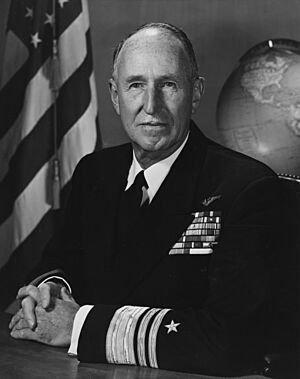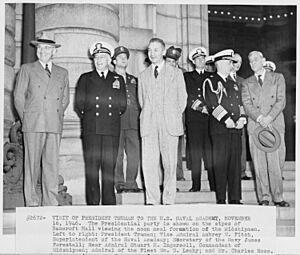Stuart H. Ingersoll facts for kids
Quick facts for kids
Stuart Howe Ingersoll
|
|
|---|---|

Ingersoll in 1955
|
|
| Born | June 3, 1898 Springfield, Massachusetts |
| Died | January 29, 1983 (aged 84) Newport, Rhode Island |
| Allegiance | United States of America |
| Service/ |
|
| Years of service | 1920–1960 |
| Rank | |
| Commands held |
|
| Battles/wars | |
| Awards |
|

Stuart Howe Ingersoll (born June 3, 1898 – died January 29, 1983) was a very important officer in the United States Navy. He was a skilled naval aviator, which means he was a pilot in the Navy. During World War II, he commanded an aircraft carrier. Later, he led the United States Seventh Fleet, became the President of the Naval War College, and was in charge of the students (called midshipmen) at the United States Naval Academy.
Contents
Stuart Ingersoll was born in Springfield, Massachusetts, on June 3, 1898. He joined the United States Naval Academy in Annapolis, Maryland, on July 19, 1917. This was during World War I, so the Navy needed many new officers.
Because of the war, the academy's usual four-year program was shortened to three years. Stuart Ingersoll was one of the top students who graduated early, on June 3, 1920. He became an ensign, which is a junior officer rank. During his time at the academy, he even sailed on a battleship called the USS Missouri (BB-11).
After graduating, Ingersoll started his naval career on the battleship USS North Dakota (BB-29) in July 1920. He then served on several destroyers, including the USS Cassin (DD-43) and the USS Hopkins (DD-249). While on the Hopkins, he was stationed in Constantinople, which is now Istanbul, Turkey.
In 1925, Stuart Ingersoll began his flight training at Naval Air Station Pensacola in Pensacola, Florida. He became a qualified naval aviator and was promoted to lieutenant in 1926. He flew for different squadrons and even served on the seaplane tender USS Wright (AV-1).
He continued to serve on various ships and at naval air stations. In 1936, he was promoted to lieutenant commander. He also studied naval strategy and naval tactics through a course from the Naval War College.
In 1937, he took command of a new squadron, Patrol Squadron 18. This squadron received new flying boat aircraft. The squadron's name changed twice under his command, becoming Patrol Squadron 13 and then Patrol Squadron 26. In 1940, he began working at the Bureau of Aeronautics in Washington, D.C.. He was promoted to commander in 1941 and then became a naval assistant in London.
World War II Hero
When the United States entered World War II in December 1941, Ingersoll played a key role. In 1942, he helped plan air operations for the U.S. Navy's support force in Newfoundland. This force protected ships from German submarines in the North Atlantic Ocean. During this time, U.S. Navy planes sank the first two German submarines destroyed by American forces in the war.
He was promoted to captain in June 1942. From 1942 to 1943, he worked at Naval Air Station Anacostia. He then transferred to the escort aircraft carrier USS Card (CVE-11). This ship hunted German submarines in the North Atlantic. For his excellent work on the Card, he received the Legion of Merit award.
Commander of the USS Monterey
On April 10, 1944, Captain Ingersoll became the commanding officer of the light aircraft carrier USS Monterey (CVL-26). The Monterey operated in the Pacific Ocean as part of the Third and Fifth Fleets. He led the Monterey during major battles like the Battle of the Philippine Sea in June 1944 and the Battle of Guam in July–August 1944. His ship also took part in air strikes against Formosa and the Battle of Leyte Gulf in October 1944.
For his bravery and leadership during these battles, he received the Navy Cross, a very high award. The award recognized how he bravely led the Monterey against Japanese air attacks and helped cause great damage to the Japanese fleet.
In December 1944, the Monterey faced a very dangerous storm called Typhoon Cobra. Planes on the ship's hangar deck broke loose and caused a fire. Even though he was told to abandon ship by Admiral William F. Halsey Jr., Ingersoll refused. He bravely directed his crew, which included future U.S. President Gerald R. Ford, to put out the fire and save the ship. His quick thinking and skill saved the Monterey. He left command of the Monterey in January 1945.
In March 1945, he became the leader of the students (Commandant of Midshipmen) at the United States Naval Academy.
After the War
After World War II ended, Stuart Ingersoll continued to serve as the Commandant of Midshipmen until 1947. Future U.S. President Jimmy Carter was one of the students at the academy during this time. In 1945, he was promoted to the rank of rear admiral.
In 1947, he became the commander of Fleet Air Wing 2. Later that year, he became the chief of staff for the Commander-in-Chief of the U.S. Pacific Fleet. By 1950, he was working in the Navy's main office, helping to plan important strategies.
Leading the Seventh Fleet
In June 1953, he became the chief of staff for the Commander-in-Chief of the United States Atlantic Fleet. On September 7, 1955, he was promoted to vice admiral. From December 1955 to January 1957, he commanded the United States Seventh Fleet. This fleet is a very important part of the U.S. Navy in the Far East. He also led the United States Taiwan Defense Command during this time, working with the government of Taiwan to help defend it.
For his leadership of the Seventh Fleet and the Taiwan Defense Command, Vice Admiral Ingersoll received the Distinguished Service Medal. This award recognized how he kept the Seventh Fleet ready for action and helped maintain peace in the region.
On August 13, 1957, Vice Admiral Ingersoll became the 31st President of the Naval War College in Newport, Rhode Island. This college is where senior naval officers go to study strategy and leadership. During his time as president, he helped the college start using computers for wargaming, which is like practicing battles using simulations. He also served on a commission that celebrated the Civil War. His time as president ended on June 30, 1960. He received another Distinguished Service Medal for his excellent work at the college.
Personal Life
Stuart Ingersoll was married twice. His first wife was Josephine Springman, and they had three children: a son named Stuart H. "Mike" Ingersoll II, and two daughters, Mary Josephine and Sally Ann. After Josephine passed away in 1964, he later married Elinore Dorrance Hill.
Death
Vice Admiral Stuart Howe Ingersoll passed away on January 29, 1983, in Newport, Rhode Island, at the age of 84.
Awards and Honors
Vice Admiral Stuart Howe Ingersoll received many awards for his long and brave service in the United States Navy. Some of his most important awards include:
- Navy Cross
- Distinguished Service Medal (with an extra award for his second one)
- Legion of Merit (with an extra award and a "V" device for valor in combat)
- Navy Commendation Medal (with an extra award)
- World War I Victory Medal
- American Defense Service Medal
- American Campaign Medal
- European-African-Middle Eastern Campaign Medal
- Asiatic-Pacific Campaign Medal
- World War II Victory Medal
- National Defense Service Medal
- Philippine Liberation Medal
- Order of the British Empire (from the United Kingdom)
 |
|||||

